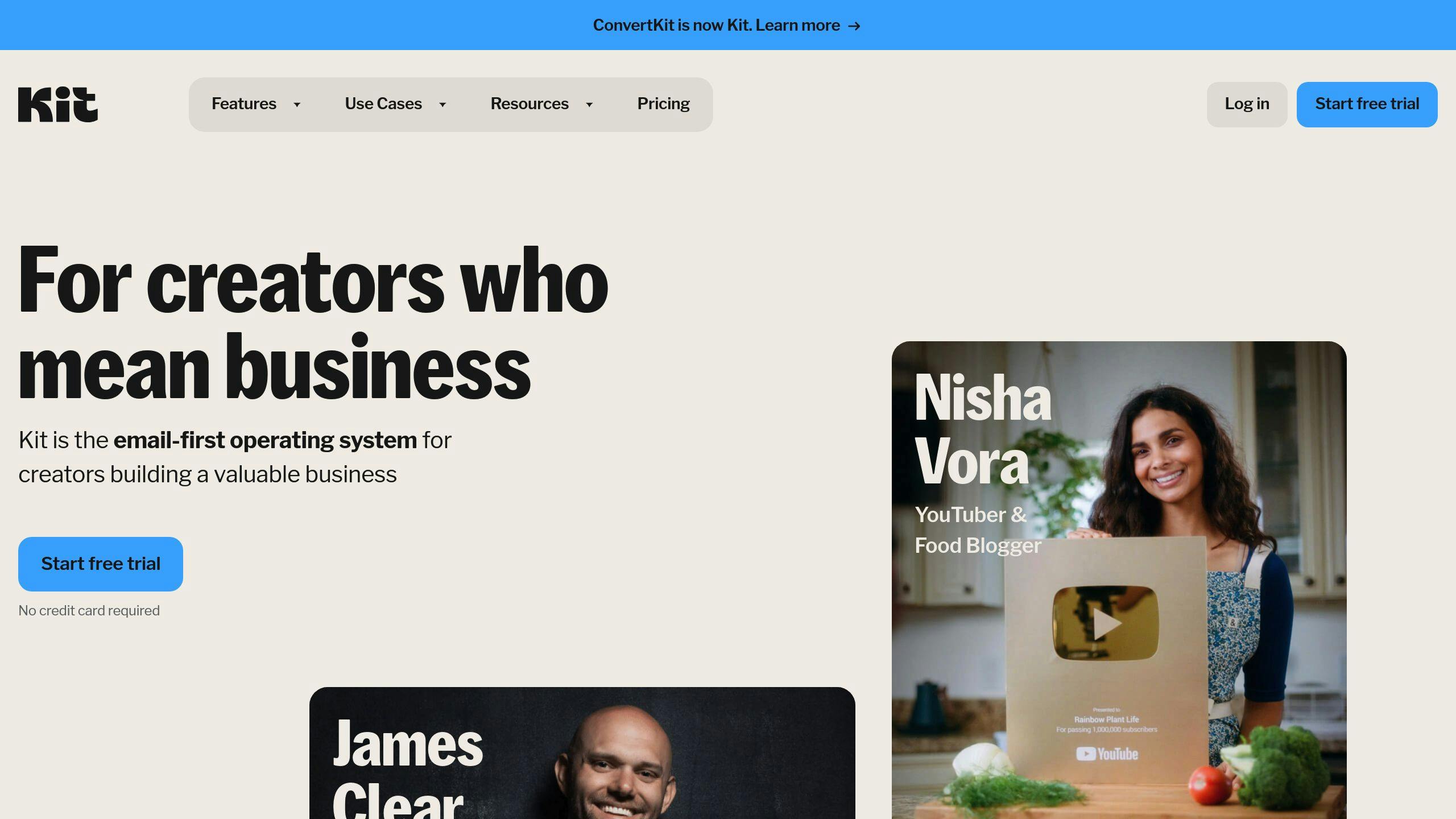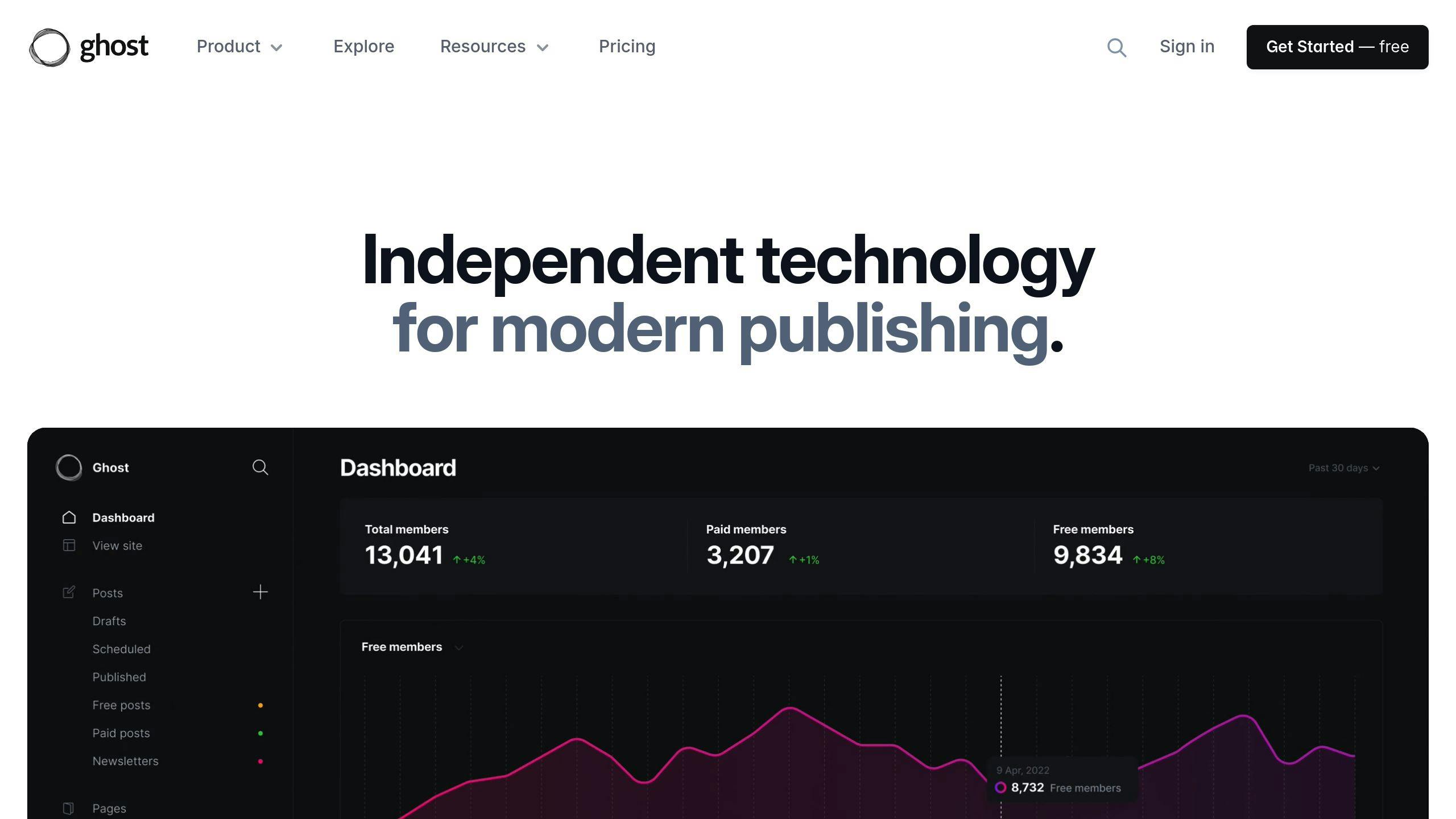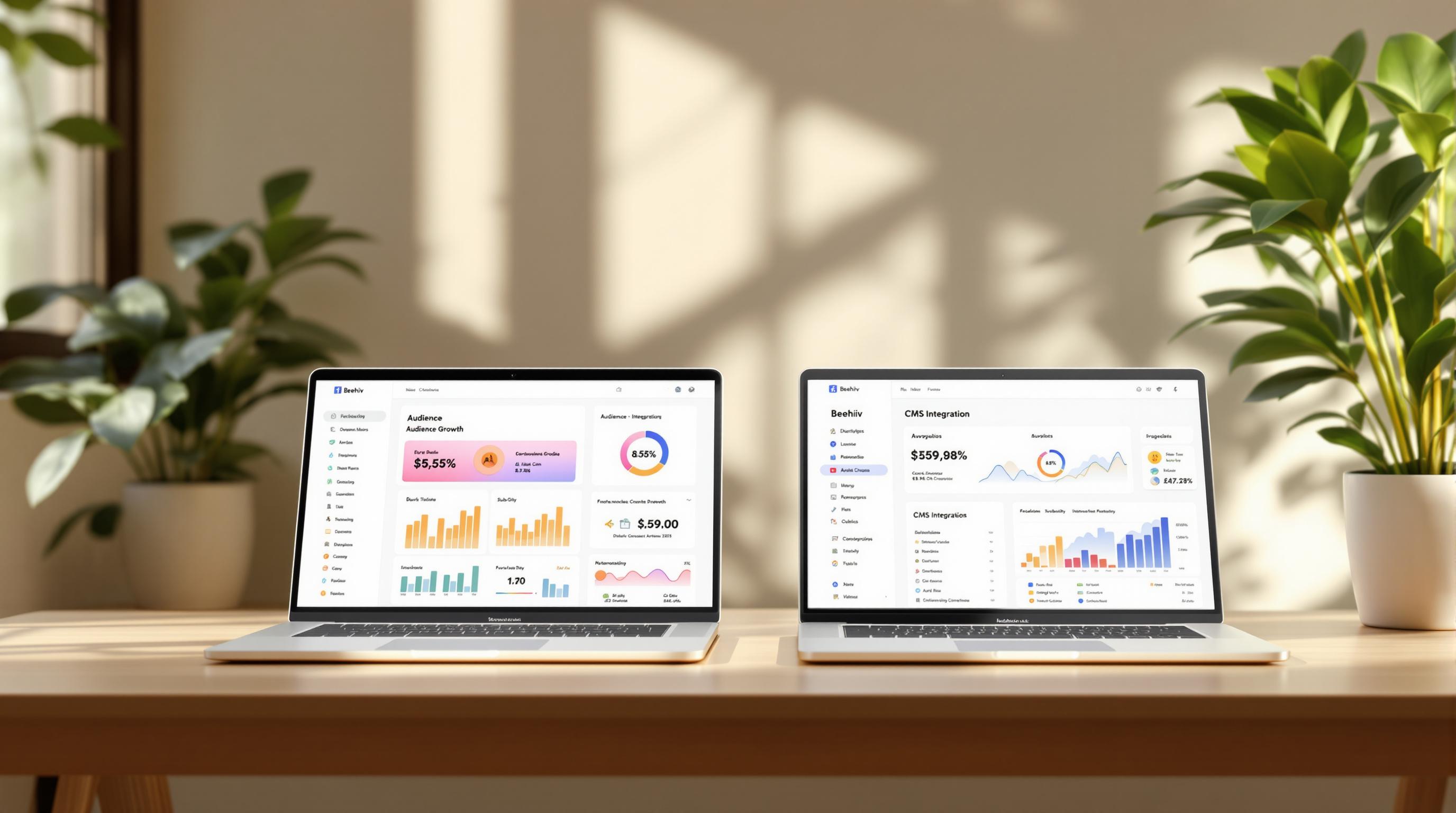Choosing the right newsletter platform depends on your needs and goals. Free platforms like Substack and Mailchimp are great for beginners, offering basic tools at no cost. Paid options, such as Beehiiv, ConvertKit, Ghost, and Mailerlite, provide advanced features like automation, monetization, and scalability for growing newsletters.
Key Differences:
- Free Platforms: Limited features, basic tools, and often revenue-sharing models (e.g., Substack takes 10% of paid subscriptions).
- Paid Platforms: Advanced tools, full revenue retention, and no subscriber caps (e.g., Ghost charges $25/month for unlimited subscribers).
Quick Comparison Table:
| Platform | Free Plan Features | Paid Plan Features | Monetization Options | Revenue Model |
|---|---|---|---|---|
| Substack | Basic tools, revenue share | Unlimited subscribers | Paid subscriptions | 10% revenue share |
| Mailchimp | 500 contacts, basic CRM | Advanced automation, e-commerce | Product sales | Tiered pricing |
| Beehiiv | 2,500 subscribers | Custom domains, ad tools | Subscriptions, ads | No revenue share |
| ConvertKit | 1,000 contacts | Automation, integrations | Subscriptions | Flat-rate pricing |
| Ghost | 500 subscribers | Unlimited subscribers, API access | Subscriptions | Flat-rate pricing |
| Mailerlite | 1,000 subscribers | Digital product sales, automation | Product sales | Tiered pricing |
Summary: Start with free plans to test the waters. Upgrade to paid plans as your audience grows for better tools, scalability, and revenue options.
1. Substack

Pricing
Substack operates on a revenue-sharing model, taking 10% of your subscription income, along with Stripe's standard payment processing fees (2.9% + $0.30 per transaction). Instead of fixed monthly costs, this approach removes upfront fees but can limit earnings as your subscriber base grows.
Customization
Substack keeps things simple, offering limited branding and design options. The platform focuses on text-heavy layouts, ensuring your content remains the star of the show rather than flashy visuals.
Scalability
Whether you're writing for a small niche or a massive audience, Substack provides tools like automated email delivery and subscriber management to grow with you. However, as your revenue increases, the 10% fee can feel like a bigger hit to your profits.
Monetization
Substack makes earning from your content straightforward. With its focus on paid subscriptions, the platform handles everything - from payment processing to managing subscriber access. This allows you to start monetizing your newsletter without dealing with complicated setups.
| Feature | Details |
|---|---|
| Revenue Share | 10% of paid subscriptions |
| Payment Processing | 2.9% + $0.30 per transaction |
| Subscription Options | Multiple pricing tiers available |
| Payment Management | Handled automatically via Stripe |
"Substack's goal is to make it easy for writers to get started with a newsletter and to give them the tools they need to succeed." - Chris Best, Co-founder of Substack
While Substack is ideal for creators just starting out, platforms like Mailchimp may offer pricing models that better suit larger-scale newsletters.
2. Mailchimp

Pricing
Mailchimp's free plan allows up to 500 contacts and 1,000 monthly email sends. Paid plans start at $13/month, covering 500 contacts and 5,000 monthly sends.
Unlike Substack, which focuses on subscription-based revenue, Mailchimp leans heavily into e-commerce integration - making it a strong option for creators with a product-first strategy.
Customization
Mailchimp features an intuitive drag-and-drop editor for easy design. For those wanting more control, it also supports HTML and CSS customization, helping you align emails perfectly with your brand.
Scalability
Mailchimp offers tiered plans that grow with your needs. Each level unlocks additional tools and features, making it easy to scale as your audience expands.
| Plan Level | Contact Limit | Monthly Sends | Key Features |
|---|---|---|---|
| Free | 500 | 1,000 | Basic templates, marketing CRM |
| Essentials | 500+ | 5,000 | A/B testing, custom branding |
| Standard | Varies | Based on contacts | Advanced automation, custom templates |
| Premium | Unlimited | Based on needs | Advanced segmentation, multivariate testing |
Monetization
Mailchimp supports businesses focused on direct sales rather than subscriptions. Key features include:
- Selling digital products directly through the platform
- Integration with major e-commerce tools
- Automated sequences for targeted engagement
- Audience segmentation for personalized promotions
"Mailchimp's built-in tools for list management and deliverability optimization make it easier for creators to maintain engagement while scaling their newsletter business", highlights a platform expert from their support documentation.
This e-commerce-first approach is ideal for businesses aiming to boost revenue through product sales instead of relying solely on subscriptions.
3. Beehiiv
Pricing
Beehiiv offers a free plan that supports up to 2,500 subscribers with unlimited email sends. As your audience grows, you can choose from various paid plans:
| Plan | Monthly Cost | Subscriber Limit | Key Features |
|---|---|---|---|
| Launch | $0 | 2,500 | Basic tools, unlimited sends |
| Scale | $39 | 1,000+ | Custom domains, polls |
| Max | $99 | Up to 100,000 | Priority support, advanced tools |
| Enterprise | Custom | Unlimited | Tailored solutions |
Customization
Beehiiv's drag-and-drop editor makes it easy to customize newsletters to your liking. Paid plans unlock additional tools, such as polls and the ability to use custom domains.
Scalability
The platform is built to grow with your audience. For example, the Max plan accommodates up to 100,000 subscribers, ensuring it can handle larger newsletters with ease.
Monetization
One standout feature of Beehiiv is that it doesn't take a revenue cut from paid subscriptions. This makes it an appealing choice for creators focused on monetizing their newsletters. You can set up premium subscription models and keep 100% of your earnings.
"Beehiiv's lack of revenue cuts and flexible pricing plans make it a favorable option for users planning to monetize their newsletters. The platform's features like premium subscriptions also support monetization efforts".
This flat-fee structure is particularly beneficial for large-scale newsletters, as it avoids the percentage-based fees common on platforms like Substack. For comparison, Substack takes a 10% revenue share, making Beehiiv a more cost-effective option for creators with high subscriber counts.
4. ConvertKit

Pricing
ConvertKit's pricing grows with your subscriber base, making it ideal for creators focused on building their audience. The free plan supports up to 1,000 contacts, while paid plans offer additional tools like automation and integrations:
| Plan | Monthly Cost | Subscriber Limit | Key Features |
|---|---|---|---|
| Free | $0 | 1,000 | Email broadcasts, landing pages |
| Creator | $29 | Up to 400,000 | Automation, integrations |
| Creator Pro | $59 | Up to 400,000 | Engagement scoring, advanced reporting |
While Beehiiv offers unlimited email sends in its free plan, ConvertKit focuses on providing scalable automation tools for creators who want to grow their paid content strategies.
Customization
ConvertKit offers extensive customization options through its drag-and-drop editor. You can design newsletters using HTML templates or a visual editor, giving you both simplicity and deeper control. This approach is similar to Substack but offers more technical flexibility for creators who need advanced design options.
Scalability
ConvertKit is built to handle growth, offering features like:
- Automation workflows to simplify managing a large subscriber base
- List segmentation for sending tailored content
- Integrations with popular e-commerce and marketing platforms
With support for up to 400,000 subscribers on paid plans, ConvertKit makes it easier to communicate effectively with a large audience.
Monetization
ConvertKit simplifies monetization by integrating direct payment processing and subscription management. This lets creators set their own pricing without relying on third-party platforms. Unlike revenue-sharing models like Substack's, ConvertKit ensures creators keep full control over their earnings.
"ConvertKit's automation and segmentation features are particularly useful for businesses and creators who need to send regular updates or promotional emails, making it easier to manage and monetize large subscriber bases".
This approach aligns with Ghost's focus on empowering creators, offering a distinct alternative to Substack's percentage-based revenue model.
sbb-itb-2653e19
5. Ghost

Pricing
Ghost uses a flat-rate pricing model with no revenue-sharing. Plans range from free (up to 500 subscribers) to $25/month for unlimited subscribers:
| Plan | Monthly Cost | Subscriber Limit | Key Features |
|---|---|---|---|
| Free | $0 | 500 | Basic features, email support |
| Starter | $9 | 1,000 | Custom domains, newsletter tools |
| Professional | $25 | Unlimited | Advanced features, API access |
This straightforward pricing stands out compared to Substack's percentage-based fees, making Ghost a better option for creators with high-earning newsletters.
Customization
Ghost provides advanced tools for those who need more technical control over their publications. Features include:
- Custom CSS for personalized design
- API and webhook integrations for third-party tools
- Customizable email templates
- Domain personalization for branding
Scalability
Designed to handle large audiences, Ghost's paid plans offer unlimited subscribers. Its infrastructure includes enterprise-level features like SPF/DKIM authentication and automated delivery optimization to ensure reliable performance.
Monetization
Ghost focuses on creator-friendly monetization by integrating directly with Stripe for payment processing. This setup allows:
- Multiple subscription tiers
- Management of recurring payments
- Full revenue retention through Stripe
Unlike platforms like ConvertKit, which emphasize automation, Ghost provides creators with greater technical control while keeping 100% of their earnings - similar to Beehiiv's approach.
6. Mailerlite
Pricing
Mailerlite uses a tiered pricing structure that adjusts based on your subscriber count. The free plan supports up to 1,000 contacts, while paid plans add features like digital sales and automation:
| Plan | Monthly Cost | Subscriber Limit | Key Features |
|---|---|---|---|
| Free | $0 | 1,000 | Basic templates, email support |
| Growing Business | $9 | 1,000 | Digital product sales, premium templates |
| Advanced | $19 | 2,500 | HTML editor, advanced automation |
Unlike Ghost's flat-rate pricing, Mailerlite adjusts its costs as your audience grows, giving flexibility for different needs.
Customization
Mailerlite makes creating branded, professional newsletters straightforward with its drag-and-drop editor. For those seeking more control, higher-tier plans include HTML editing. Features include:
- Pre-designed, customizable newsletter templates
- Built-in design tools to ensure brand consistency
- Mobile-friendly, responsive layouts
- Custom HTML editing available on the Advanced plan
These tools allow users to create polished newsletters, even without technical expertise.
Scalability
Mailerlite supports growing businesses with tools designed to handle larger audiences and improve efficiency:
- Advanced segmentation to target specific subscriber groups
- Workflow automation for streamlined email campaigns
- Performance analytics to measure success
- Optimized email delivery for better engagement
Monetization
Mailerlite takes an e-commerce-first approach to monetization, focusing on tools for selling products directly. While it doesn’t offer an ad network like Beehiiv, it provides features that cater to businesses looking to generate revenue through sales rather than subscriptions.
Key monetization features include:
- Digital product sales functionality
- Tools for managing subscriptions
- Integration with payment processors
- Revenue tracking to monitor earnings
This approach makes Mailerlite a strong option for creators and businesses prioritizing direct sales.
Newsletter Platform Comparison: Beehiiv vs Substack
Advantages and Disadvantages
When deciding which platform fits your needs best, consider these three main factors: your current stage, goals, and resources.
For Early-Stage Testing
Free Platform Advantages:
- No upfront costs make it easy to get started.
- Quick and simple setup, even for beginners.
- Comes with built-in tools to help you reach an audience.
Drawbacks:
- Revenue sharing can cut into your earnings.
- Limited options for customizing your brand.
- Analytics and scalability might not meet growing needs.
For Expanding Newsletters
Paid Platform Advantages:
- Offers professional branding options to elevate your newsletter.
- Includes automation tools to save time and streamline workflows.
- Flexible monetization options to fit various revenue strategies.
- Provides detailed analytics to track performance and growth.
Drawbacks:
- Monthly fees can add up, especially for smaller newsletters.
- Features may take time to master, requiring a learning curve.
- Higher upfront investment compared to free platforms.
- Managing advanced features can be complex.
Choosing the right platform comes down to factors like:
- Your newsletter's current audience size and growth plans.
- How much customization and technical expertise you need.
- Budget limitations and your preferred revenue approach.
- The level of automation and analytics you require.
The best platform strikes a balance between ease of use now and the ability to grow with you over time.
Conclusion
When comparing free and paid newsletter platforms in 2025, think about both your current needs and how your newsletter might grow over time. Whether it's Substack's revenue-sharing model or Ghost's flat-rate pricing, the right choice will depend on your goals and future plans.
For those just getting started, free options like Mailchimp's basic plan are a great way to test the waters with minimal risk. But as your audience grows, investing in a paid platform becomes worthwhile for its advanced tools and ability to handle larger subscriber bases.
Pricing varies widely across platforms. For example, Ghost offers predictable costs with its $25/month flat fee for unlimited subscribers, making it an appealing option for creators looking for clear pricing and a strong set of features.
Here are some key trends shaping newsletter platforms in 2025:
- AI Tools: Helping creators optimize content and better target their audience
- Improved Automation: Making workflows smoother and more efficient
- New Revenue Streams: Expanding beyond traditional subscription models
Start small with free plans to experiment, then upgrade as your needs grow. The best platform will evolve with your newsletter, offering the tools and pricing structure to support your long-term success.


